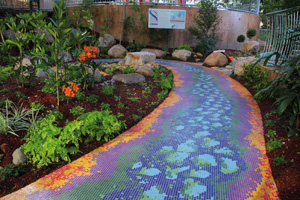A Sound Garden with a Japanese water harp (sui-kin-kutsu) has been installed in Brisbane’s Roma St Parkland, Queensland.

Roma St Parkland Sound Garden, 2009. The Japanese water harp is encircled by a glass mosaic path of the Turrbul Dreaming Freshwater Eel. Photograph by Hideki Okubo. This image will be featured in a postage stamp.
This Sound Garden is designed with a water harp, sui-kin-kutsu, as a central feature. Sui-kin-kutsu, written as 水sui (water) 琴kin (harp) 窟kutsu (cave), is an inverted terracotta pot (40 to 60cm in depth) buried underground with a small hole at the top (3cm in diameter) through which water drips. It is devised so that water pools about 10cm at the bottom, leaving the rest harrow. The sounds can be tuned by varying the depth of the water. Slow dripping water splashes in the water pool and rings, creating a harp-like sound, hence the name suikinkutsu. As the water drips in multiple random drops, melodic tunes are created.
[For more, read the special Arts of Sound November 2009 Issue of Art Monthly Australia www.artmonthly.org.au]
Dr Kumi Kato is Professor in Environmental Studies, Wakayama University, Japan, and a Research Associate at the Australian Centre for Peace & Conflict Studies, The University of Queensland.
References
[1] The author acknowledges valuable contributions made by the project team, especially the work provided by Yoshinobu Kubo (Kubo Zouen, Kyoto), Hideki Okubo and Simon Wearne.
 This work is licensed under a Creative Commons Attribution-NonCommercial-ShareAlike 2.5 Australia.
This work is licensed under a Creative Commons Attribution-NonCommercial-ShareAlike 2.5 Australia.






